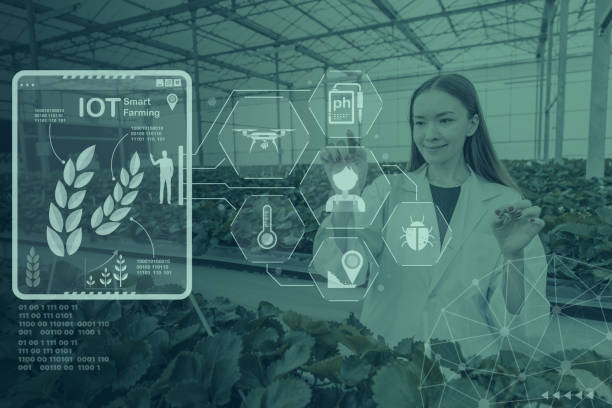
In the modern era, the integration of technology into agriculture, known as smart agriculture, has revolutionised the way we grow crops and raise livestock.
Internet of Things (IoT) technology plays a pivotal role in this transformation, allowing farmers to make data-driven decisions to enhance efficiency and yield.
In this article, we’ll delve into the process of creating a smart agriculture system using IoT.
Understanding the Components of a Smart Agriculture System
According to Techtarget, a smart agriculture system comprises various interconnected components that work harmoniously to collect, transmit, and analyse data.
These components include sensors that measure soil moisture, temperature, humidity, and more.
These sensors send data to a central hub that processes the information and provides insights into the condition of the crops and the environment.
Setting Up IoT Sensors

The foundation of any smart agriculture system is IoT sensors.
These sensors act as the eyes and ears of the farm, providing real-time data on various environmental factors.
For instance, soil moisture sensors detect the water content in the soil, helping farmers make informed decisions about irrigation schedules.
IBM says installing and calibrating these sensors correctly is crucial for accurate data collection.
Data Transmission and Collection
IoT systems rely on effective data transmission and collection.
This involves using wireless communication technologies such as LoRaWAN or NB-IoT to transmit data from sensors to the central hub.
Farmers can then access this data through user-friendly interfaces, such as mobile apps or web dashboards, enabling them to monitor the farm’s conditions remotely.
Data Analysis and Decision Making
The wealth of data collected by IoT sensors provides farmers with valuable insights that can transform their decision-making process.
AI-powered algorithms can analyse data patterns and predict optimal times for planting, harvesting, and more.
This data-driven approach minimises waste and maximises yield, resulting in a more sustainable and profitable farming operation.
Implementing Automation and Control
One of the key advantages of a smart agriculture system is the ability to automate tasks.
For example, based on data from soil sensors and weather forecasts, the system can automatically control irrigation systems to ensure optimal water usage.
ResearchGate cited that automation not only saves time and labour but also leads to resource-efficient practices.
Challenges and Future Outlook
While the potential of IoT in agriculture is immense, challenges such as data privacy, connectivity issues, and initial setup costs need to be addressed.
However, as technology advances and more farmers embrace smart agriculture practices, the costs are likely to decrease, making these systems more accessible.
The future of agriculture lies in harnessing the power of IoT to create more sustainable and productive farming practices.
Okay my lovely readers, now let us look into some frequently asked questions (FAQs) about How to create a smart agriculture system with IoT.
How can I create a smart agriculture system using IoT?
To build a smart agriculture system with IoT, select appropriate sensors for soil moisture, temperature, and other variables, connect them to a microcontroller like Arduino, and use IoT platforms to collect, analyse, and manage data.
What benefits does a smart agriculture system offer?
A smart agriculture system optimises resource usage, enhances crop yield, enables remote monitoring, reduces manual labour, and contributes to sustainable farming practices.
Do I need advanced technical skills for setting up a smart agriculture system?
While some technical knowledge helps, there are resources and tutorials available to guide beginners. IoT development platforms offer user-friendly tools for setup.
How can I ensure the security of my smart agriculture system?
Ensure security by implementing strong authentication mechanisms, encrypting data transmission, using secure IoT platforms, and regularly updating firmware and software.
People Also Ask:
What types of sensors are used in a smart agriculture system with IoT?
Sensors for soil moisture, temperature, humidity, light, and even GPS location are commonly used. These sensors provide vital data for informed decision-making in farming.
How does IoT technology improve irrigation management in agriculture?
IoT-enabled irrigation systems use real-time data from soil moisture sensors to optimise water usage.
This ensures that crops receive the right amount of water, reducing waste and enhancing yield.
Can a smart agriculture system be controlled remotely?
Yes, IoT technology allows remote monitoring and control of various parameters in agriculture, such as irrigation, pest control, and greenhouse conditions, enabling efficient management even from a distance.
How does a smart agriculture system contribute to sustainable farming?
By leveraging data-driven insights, a smart agriculture system promotes efficient resource utilisation, minimises overuse of water and chemicals, reduces waste, and supports environmentally friendly farming practices.
Conclusion
In conclusion, the synergy between IoT and agriculture has opened doors to smarter, more efficient farming practices.
By understanding the components, setting up sensors, analysing data, and implementing automation, farmers can create a robust smart agriculture system that not only boosts yield but also contributes to a more sustainable future.
The journey to smart agriculture is a transformative one, bridging the gap between technology and the age-old practice of farming.








